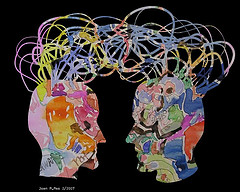Overview of Complexity of Learner Language
Social Language and Academic Language
Most communicative tasks used in language classrooms focus on what Cummins (1981, 2000) has called social language, or "basic interpersonal communication." Social language typically refers to concrete, observable things, people, and actions. Social language is supported by contextual information (e.g., visual information about people and places) that clarifies what is communicated verbally.
Academic language proficiency is the ability to use cognitively demanding language (e.g. abstract nouns and complex syntax) as a tool for critical thinking, with little contextual support in the sending and receiving of information.
 Language Complexity
Language Complexity
Cognitive complexity is related to complexity in language, both sentence structure and lexicon. A functional linguistics perspective (Schleppegrell, 2004) shows how language forms function to express a wide range of logical relationships in academic discourse. For example, what words signal the logical relationship between an inference and the facts that support it? In English, the function of inference may be expressed using abstract words like 'wealthier', while the function of evidence may consist of observable, concrete words, such as 'garage,' 'car,' 'peeling paint', or 'satellite dish'. Linguistic constructions like 'because' or 'just based on' are also needed for the function of linking inferences to support (Lackstrom, 1981).
Academic language is characterized by an increase in abstract nouns; very complex noun phrases with multiple levels of embedding; and relative, adverbial and complement clauses (Biber 2006). Such linguistic variety is more cognitively demanding. In addition, the lack of contextual support puts pressure on the speaker to be more precise, to make sure the listener understands. Higher levels of proficiency entails mastery of the more complex registers and uses of academic language.
Measuring Syntactic Complexity
How do we measure the syntactic complexity of learner language? Different measures are used for written vs. spoken language. The T-unit is a common measure of complexity in written language. But T-units don't work so well with spoken language, which typically has sentence fragments, false starts, and turn overlaps. In looking at spoken English L2, Tarone & Swierzbin (2009) counted the number of sentences containing more than one verb. However, you could also count learners' complex noun phrases, or verb arguments, or various types of dependent clauses, like relative or infinitive clauses. (Ellis & Barkhuizen, 2005, p.147-156) detail how to use different complexity measures for both written and spoken learner language.
Measuring Lexical Complexity
One useful way to measure complexity in vocabulary is to document variety in the words occurring in a segment of language. A type-token ratio (TTR) is the total number of different words (types) divided by the total number of words (tokens) in a given segment. For example, that last sentence contains 24 different words (tokens), but several of those words (like ‘a’, ’the’, ‘words’) occur more than once, so there are only 18 types. The TTR of that sentence is 18/24. The closer the TTR ratio is to 1, the greater the lexical richness of the segment. Usually written language has a higher TTR than spoken language.
Another way to analyze social vs. academic vocabulary is to measure learners' use of concrete vs. abstract nouns. Increased use of abstract nouns might be one signal of increased cognitive complexity, since abstract nouns refer to concepts and categories that are used in performing higher level cognitive operations (see Bloom's revised taxonomy in Anderson & Krathwohl, 2001).
Learning more
To read more about the linguistic and functional characteristics of academic language, see Schleppegrell, 2004; for ideas on teaching academic language, see Zwiers(2008) and his useful website. Ellis & Barkhuizen (2005, p. 147-156) provide very useful examples showing how measures of syntactic complexity work, and Robinson (1995) illustrates type-token ratios (TTR).
Multimedia Activities focused on Complexity
Graphic used with Creative Commons permission, from:
http://www.flickr.com/photos/dailypic/1459055735/
